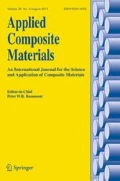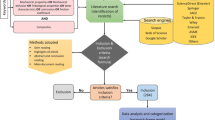Abstract
Artificial Neural Networks (ANN) have been successfully used in predicting the fatigue behavior of fiber-reinforced composite materials. In most cases, the predictions were obtained for the same material used in training subjected to different loading conditions. The method would be of greater value if one could predict the failure of materials other than those used for training the network. In a recent paper, ANN trained using the experimental fatigue data obtained for composites subjected to a constant stress ratio \( \left( {{\hbox{R}} = {\sigma_{{ \min }}}/{\sigma_{{ \max }}}} \right) \) was successfully used to predict the cyclic behavior of a composite made of a different material. In this work, this method is extended to include the stress ratio effect. The results show that ANN can provide accurate fatigue life prediction for different materials under different values of the stress ratio. These results can allow for the development of a materials smart database that can be used for various engineering applications.










Similar content being viewed by others
References
El Kadi, H.: Modeling the mechanical behavior of fibre reinforced polymeric composite materials using artificial neural networks—A review. Compos. Struct. 73, 1–23 (2006)
Zhang, Z., Friedrich, K.: Artificial neural networks applied to polymer composites: a review. Compos. Sci. Tech. 63, 2029–2044 (2003)
Schalkoff, R.J.: Artificial neural networks. McGraw-Hill. (1997)
Haykin, S.: Neural networks—A comprehensive foundation, 2nd ed. Prentice Hall. (1999)
Skapura, D.: Building neural networks. ACM Press, Addison-Wesley (1996)
Elman, J.L.: Finding structure in time. Cog. Sci. 14, 179–211 (1990)
Hagan, M.T., Demuth, H.B., Beale, M.H.: Neural network design. Campus Publishing, University of Colorado at Boulder. (2002)
Aymerich, F., Serra, M.: Prediction of fatigue strength of composite laminates by means of neural network. Key Eng. Mater. 144, 231–240 (1998)
Lee, J.A., Almond, D.P., Harris, B.: The use of neural networks for the prediction of fatigue lives of composite materials. Compos. A 30, 1159–1169 (1999)
Al-Assaf, Y., El Kadi, H.: Fatigue life prediction of unidirectional glass fibre/epoxy composite laminate using neural networks. Compos. Struct. 53, 65–71 (2001)
El Kadi, H., Al-Assaf, Y.: Prediction of fatigue life of unidirectional glass fibre/epoxy composite laminae using different neural network paradigms. Compos. Struct. 55, 239–246 (2002)
Vassilopoulos, A.P., Georgopoulos, E.F., Dionysopoulos, V.: Artificial neural networks in spectrum fatigue life prediction of composite materials. Int. J. Fatigue 29, 20–29 (2007)
Freire Júnior, S.R.C., Neto, A.D.D., de Aquino, E.M.F.: Use of modular networks in the building of constant life diagrams. Int. J. Fatigue 29, 389–396 (2007)
Freire Júnior, S.R.C., Neto, A.D.D., de Aquino, E.M.F.: Building of constant life diagrams of fatigue using artificial neural networks. Int. J. Fatigue 27, 746–751 (2005)
Freire Júnior, S.R.C., Neto, A.D.D., de Aquino, E.M.F.: Comparative study between ANN models and conventional equations in the analysis of fatigue failure of GFRP. Int. J. Fatigue 31, 831–839 (2009)
Adam, T., Fernando, G., Dickson, R.F., Reiter, H., Harris, B.: Fatigue life prediction for hybrid composites. Int. J. Fatigue 11, 233–237 (1989)
El Kadi, H., Al-Assaf, Y.: The use of neural networks in the prediction of the fatigue life of different composite materials, 16th Int Conf on Compos Mater, Japan, July 8–13, 2007
Al-Assadi, M., El Kadi, H., Deiab, I.M.: Predicting the fatigue life of different composite materials using artificial neural networks. App. Compos. Mater. 17, 1–14 (2010)
Hashin, Z., Rotem, A.: A fatigue failure criterion for fiber reinforced materials. J. Compos. Mater. 7, 448–464 (1973)
Awerbuch, J., Hahn, H.T.: Off-axis fatigue of graphite/epoxy composites. In: Lauraitis, K.N. (ed.) Fatigue of Fibrous Composite Materials, ASTM STP 723, pp. 243–273. Am Soc Test Mater, Philadelphia (1981)
El Kadi, H., Ellyin, F.: Effect of stress ratio on the fatigue of unidirectional glass fibre/epoxy composite laminae. Compos 25, 917–924 (1994)
Philippidis, T.P., Vassilopoulos, A.P.: Complex stress state effect on fatigue life of GRP laminates. Part I, Experimental. Int. J. Fatigue 24, 813–823 (2002)
Kawai, M., Suda, H.: Effects of non-negative mean stress on the off-axis fatigue behavior of unidirectional carbon/epoxy composites at room temperature. J. Compos. Mater. 38, 833–854 (2004)
Jen, M.-H.R., Lee, C.-H.: Strength and life in thermoplastic composite laminates under static and fatigue loads. Part I: Experimental. Int. J. Fatigue 20, 605–615 (1998)
Epaarachchi, J.A., Clausen, P.D.: An empirical model for fatigue behavior prediction of glass fiber reinforced plastic composites for various stress ratios and test frequencies. Compos. A 34, 313–326 (2003)
Harris, B., Reiter, H., Adam, T., Dickson, R.F., Fernando, G.: Fatigue behaviour of carbon fibre reinforced plastics. Compos 21, 232–242 (1990)
Fernando, G., Dickson, R.F., Adam, T., Reiter, H., Harris, B.: Fatigue behavior of hybrid composites: Part 1 Carbon/Kevlar hybrids. J. Mater. Sci. 23, 3732–3743 (1988)
MATLAB: www.mathworks.com
Al-Assadi, M.: Predicting the fatigue failure of fiber reinforced composite materials using artificial neural networks. MS Thesis. American University of Sharjah (2009)
Author information
Authors and Affiliations
Corresponding author
Rights and permissions
About this article
Cite this article
Al-Assadi, M., El Kadi, H.A. & Deiab, I.M. Using Artificial Neural Networks to Predict the Fatigue Life of Different Composite Materials Including the Stress Ratio Effect. Appl Compos Mater 18, 297–309 (2011). https://doi.org/10.1007/s10443-010-9158-7
Received:
Accepted:
Published:
Issue Date:
DOI: https://doi.org/10.1007/s10443-010-9158-7




